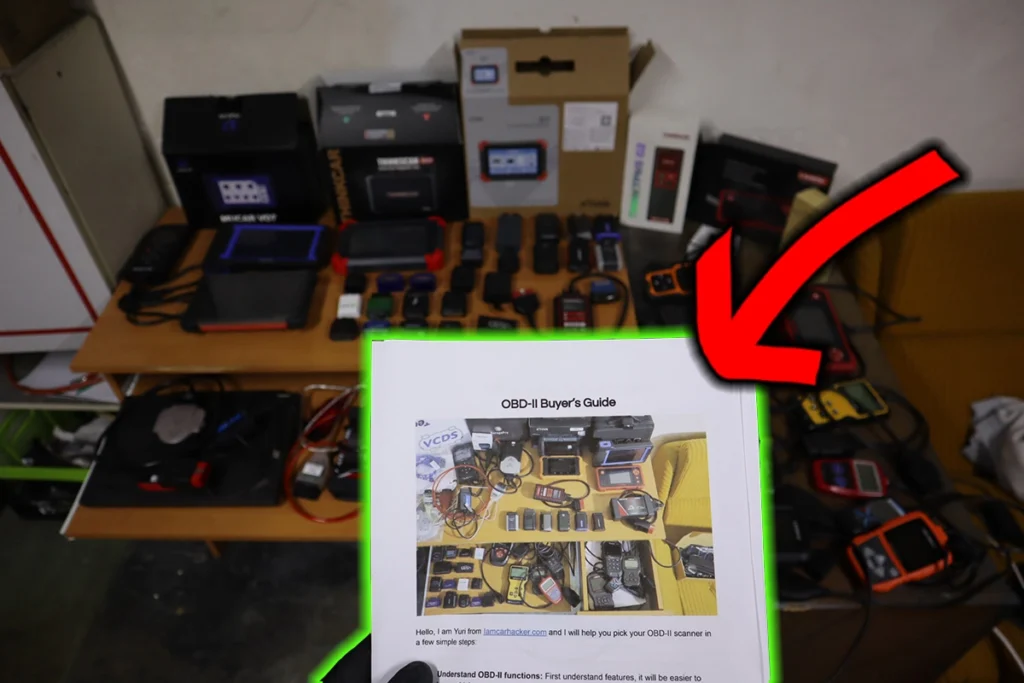If you are just a general car owner or starting hobby mechanic, you might feel confused after looking at the engine live data on your freshly purchased OBD2 scanner.
I will briefly explain the basic live data to help you understand what you are looking at.
Yesterday I talked about Bi-Directional testing, if you missed it, read it here.
Today it will be a longer lesson, but it is one of the most useful knowledge to become a real mechanic, not just a parts-changer.
You would be surprised how many of the “professional” mechanics don’t know even these basics.
I am talking about engine live data.
So let’s dive in:
Bank 1 vs Bank 2
The inline engine has only Bank 1, so only 1 set of cylinders.

The V-shaped engine has 2 sets of cylinders, Bank 1 and Bank 2 so most of the data we go over, you can see twice. Once for Bank 1, second time for Bank 2.

What It Is:
Modern engines often have multiple cylinders arranged in separate groups called banks. Bank 1 refers to the side of the engine with cylinder #1, while Bank 2 is the opposite side. Monitoring data for each bank helps identify issues specific to one side of the engine.
Fuel System Status

What It Is:
This parameter indicates the current status of the fuel system, such as open loop or closed loop operation. Open loop means the engine is not using feedback from the oxygen sensors, while closed loop means it is.
Expected Range:
- Open Loop: Engine warming up or high demand conditions.
- Closed Loop: Normal operating conditions where the ECU adjusts fuel delivery based on sensor data.
Calculated Load Value

What It Is:
Represents the engine’s current load as a percentage, showing how much power the engine is using relative to its maximum capacity.
Expected Range:
Around 18% (idle) to 100% (full load). Typically, values range between 0-100%, with higher percentages indicating higher engine demand.
Engine Coolant Temperature

What It Is:
Measures the temperature of the engine’s coolant, which is crucial for maintaining optimal engine performance and preventing overheating.
Expected Range:
- Normal Operating Temperature: 160°F to 220°F (71°C to 104°C)
- Warning Threshold: Above 220°F (104°C)
Short Term Fuel Trim

What It Is:
Adjustments made by the ECU to the fuel injection in the short term based on immediate sensor feedback to maintain the optimal air-fuel ratio.
Expected Range:
- Normal: -10% to +10%
- Values outside this range may indicate issues like vacuum leaks or faulty sensors.
Long Term Fuel Trim

What It Is:
Long-term adjustments to the fuel injection system based on extended sensor data trends, helping to compensate for gradual changes in engine performance.
Expected Range:
- Normal: -20% to +20%
- Significant deviations can suggest persistent issues such as injector problems or exhaust leaks.
Intake Manifold Absolute Pressure (MAP)

What It Is:
Measures the pressure inside the intake manifold, which helps the ECU determine the engine load and adjust fuel delivery accordingly.
Expected Range:
- At sea level: 75 kPa (kilopascals) to 105 kPa
- Under boost: Higher values depending on the turbocharger or supercharger
Engine Speed (RPM)

What It Is:
Tracks the number of revolutions the engine makes per minute, indicating how hard the engine is working.
Expected Range:
- Idle: 600 to 1000 RPM
- Normal Driving: 1000 to 4000 RPM
- Redline: Varies by vehicle, typically between 6000 to 8000 RPM
Vehicle Speed

What It Is:
Displays the current speed of the vehicle as detected by the vehicle speed sensor.
Expected Range:
0 to the vehicle’s maximum speed capability. Should correspond accurately with the speedometer.
Ignition Timing Advance

What It Is:
Shows the degree to which the ignition timing is advanced before the piston reaches the top of its compression stroke, optimizing engine performance and efficiency.
Expected Range:
- Typically: 10° to 40° before Top Dead Center (BTDC)
- Varies based on engine load and RPM
Absolute Throttle Position

What It Is:
Indicates the position of the throttle valve, which controls the amount of air entering the engine.
Expected Range:
0% (closed) to 100% (fully open). Smooth and responsive changes correlate with proper throttle function.
Oxygen Sensor 1

What It Is:
The first oxygen sensor, usually located before the catalytic converter, measures the oxygen level in the exhaust gases to help regulate the air-fuel mixture.
Expected Range:
- Voltage: 0.1V (lean) to 0.9V (rich)
- Switching between low and high voltage indicates proper sensor function
Oxygen Sensor 2

What It Is:
The second oxygen sensor, typically located after the catalytic converter, monitors the efficiency of the catalytic converter by comparing pre- and post-converter oxygen levels.
Expected Range:
- Voltage: 0.1V to 0.9V
- Should show less fluctuation compared to Oxygen Sensor 1 if the catalytic converter is working correctly
Equivalence Ratio
What It Is:
A ratio that indicates the air-fuel mixture’s richness or leanness relative to the stoichiometric ideal.
Expected Range:
- Stoichiometric Ratio: 1.0
- Below 1.0: Lean mixture
- Above 1.0: Rich mixture
Time Since Engine Start
What It Is:
Tracks the time elapsed since the engine was last started, useful for diagnosing intermittent issues and understanding system warm-up cycles.
Expected Range:
Starts at 0 when the engine is started and increases continuously until the next engine shutdown.
OBD Requirements

What It Is:
Ensures that the vehicle’s onboard diagnostics system meets the necessary standards for emissions and performance monitoring.
Expected Range:
Compliant vehicles should show all required systems as “Complete” or “Ready.” Non-compliance may indicate pending or unresolved issues.
Intake Air Temperature (IAT)
What It Is:
Measures the temperature of the air entering the engine, which affects air density and engine performance.
Expected Range:
- Normal: -40°C to 125°C (-40°F to 257°F)
- Optimal operating range varies based on engine design
Mass Airflow Rate (MAF)
What It Is:
Quantifies the amount of air entering the engine, allowing the ECU to calculate the correct amount of fuel to inject.
Expected Range:
Depends on engine size and speed, typically ranging from 0 to 100 grams per second (g/s).
Distance Traveled Since DTC Cleared
What It Is:
Shows how far the vehicle has driven since the last Diagnostic Trouble Code (DTC) was cleared, helping track if issues reoccur.
Expected Range:
Starts at 0 after clearing and increases continuously. There’s no upper limit, but frequent resets may indicate recurring problems.
Barometric Pressure
What It Is:
Measures the atmospheric pressure, which can influence engine performance and fuel delivery.
Expected Range:
- Sea Level: ~101 kPa (kilopascals)
- Varies with altitude and weather conditions
Catalyst Temperature Sensor 1
What It Is:
Monitors the temperature of the catalytic converter to ensure it’s operating within safe and efficient parameters.
Expected Range:
- Normal Operating Temperature: 400°C to 800°C (752°F to 1472°F)
- Varies based on engine load and speed
Catalyst Temperature Sensor 2
What It Is:
Provides additional temperature data from another point on the catalytic converter, helping to assess overall converter performance.
Expected Range:
Similar to Catalyst Temperature Sensor 1, typically 400°C to 800°C (752°F to 1472°F).
Control Module Voltage
What It Is:
Indicates the voltage level supplied to the vehicle’s control modules, ensuring they receive adequate power to function correctly.
Expected Range:
- Normal: 12.0V to 14.0V (when the engine is running)
- Low Voltage: Below 12.0V may indicate electrical issues
Outside Air Temperature
What It Is:
Measures the temperature of the air outside the vehicle, which can influence engine performance and fuel efficiency.
Expected Range:
- Typically: -40°C to 215°C (-40°F to 419°F)
- Depends on the vehicle’s location and environmental conditions
Engine Run Time Since DTC Cleared
What It Is:
Tracks how long the engine has been running since the last Diagnostic Trouble Code (DTC) was cleared, useful for monitoring system stability.
Expected Range:
Starts at 0 when DTCs are cleared and increases continuously. No upper limit, but short run times may indicate recent code clearing.
Type of Fuel Currently
What It Is:
Displays the type of fuel the vehicle is using, such as gasoline, diesel, or ethanol blends, which can affect engine tuning and performance.
Expected Range:
- Common Types: Gasoline, Diesel, E85, Flex Fuel
- Depends on the vehicle’s fuel system and configuration
Engine Exhaust Flow Rate
What It Is:
Measures the rate at which exhaust gases are expelled from the engine, indicating the efficiency of the combustion process and exhaust system.
Expected Range:
Varies based on engine size and speed, typically measured in grams per second (g/s). Optimal ranges depend on the specific engine design.
Good job getting so far. Now, of course,e you will probably not remember all of these, but you can always go back to this email when you need to refresh your memory.
P.S. The Extended version of this email course, including 60 video lessons to help you master DIY diagnostics, is available HERE.
Free PDF: How to choose OBD2 scanner

I’ve made you a free PDF to choose the OBD2 scanner in 5 minutes.
✅ Which OBD2 scanner is best?
✅ Which type should you get (DIY, Pro, Hobby)
✅ What is the best scanner for the exact brand/feature (e.g best for BMW)
✅ How to get a Bi-Directional tool for as cheap as $40
✅ Discount coupons for scanners
PDF is 100% free and it is designed to help you pick a scanner in less than a few minutes! Not a boring 50-page guide.
Just tell me where to send it.

Hi, I am Juraj “Yuri” Lukacko. I got frustrated by unhelpful and scammy mechanics, so I decided to learn everything about car diagnostics myself. I test dozens of new car diagnostic tools every month along with learning new strategies to fix and customize cars. About Juraj Lukacko (Yuri)

thank you for good information
No problem, I am happy its helpful.
Thanks for the explanations. For a music project I am working on I want to read Vehicle speed, RPM and throttle in realtime and send that data to my application (running on Mac OS). What scanner do you suggest for that? Thanks
You can do that with Veepeak + Car Scanner app and then export data to your computer
hello sir, thanks for the great information. but i have a 2014 mirage with no engine codes but it consumes twice the recommended fuel. the upstream oxygen sensor reads from 2v-4v with all scanners i have used. is that possible or its always between 0.1 and 0.9v. also i smell gas in the exhaust fumes when i spark, until iit warms up.
hello
in Manifold Absolute Pressure (MAP) part you said: “… while wide-open throttle should be 250-300 kPa.”
It seems that this number is wrong. Because the sea level pressure is about 101kpa. My car shows 89 in this mode at an altitude of 900 meters.
Of course, I know that the situation is different for turbocharged cars.
I have a question that I couldn’t find the answer to no matter what I searched on the internet. In the diagnostic devices used by mechanics, the amount of injector fuel injection is shown in each cycle. Is there a dongle and software that will give me this number?